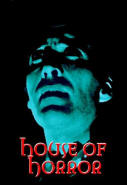ARTICLES
The
Dracula Myth
This was
in fact the second article to appear on the Unofficial Hammer Films website back in
August 1999.
Curiously enough, I hadn't then seen either Dracula Has Risen From the Grave or
Taste the Blood of Dracula - hence the entries for both films are blank
- RJES 2006
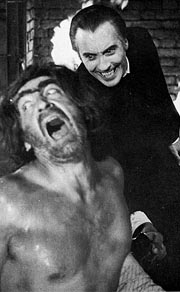 THE first thing which must be stated when
dealing with Hammer's wondrous legacy of Dracula films, is that
Christopher Lee is Dracula. Most of you already know that, I'm
sure. Chris flares with charisma and sophistication. When he
steps onto the screen, particularly as the count, one just pauses
and is transfixed by his style and elegance. Hammer's version of a
rather grand Englishman was something of a change from the
Romanian stilted portrayal by the great Bela Lugosi. His
portrayal seemed somewhat more authentic with him actually coming
from the area. Lee however was slightly more believable, a damn
sight more frightening, and spilling over with sexual charm.
THE first thing which must be stated when
dealing with Hammer's wondrous legacy of Dracula films, is that
Christopher Lee is Dracula. Most of you already know that, I'm
sure. Chris flares with charisma and sophistication. When he
steps onto the screen, particularly as the count, one just pauses
and is transfixed by his style and elegance. Hammer's version of a
rather grand Englishman was something of a change from the
Romanian stilted portrayal by the great Bela Lugosi. His
portrayal seemed somewhat more authentic with him actually coming
from the area. Lee however was slightly more believable, a damn
sight more frightening, and spilling over with sexual charm.
The decision
to move into the horror genre was a wise one for Hammer. Over the
next twenty years they would reunite international stars (thanks
to The Curse of Frankenstein in 1957) Peter Cushing and
Christopher Lee many times in the Dracula series of films, and
Peter Cushing would shine in the Frankenstein series.
The
development of the characters in the Dracula series was
pronounced and elaborate, moving through the ages, as was Hammer's
treatment of the vampire in general. And yet, although the most
popular series of Hammer's films, the legend told about Dracula,
even in the first of the films, is far from that painted by Bram
Stoker in his classic gothic novel. Something I realised when I
finally got hold of a copy of Dracula on video the other
year.
The company
took the legend beyond the confines of Bram Stoker's novel and
gave the character real identity and setting him in a wealth of
strange places, from Transylvania to Germany to London to Hong
Kong.
Dracula
1958
CHRISTOPHER LEE and PETER CUSHING
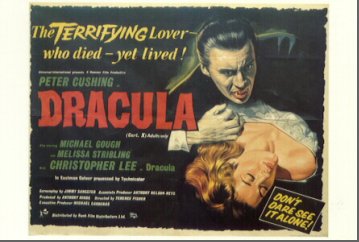 The first of Hammer's
Dracula pictures was based only loosely around Bram Stoker's
classic novel, but yet is still far removed from Universal's
classic starring Bela Lugosi. Hammer used a great British cast
including Michael Gough, but the relationships between Jonathan
Harker and everyone else are seriously warped. I still get
confused when I watch it. No one is as they are in the book,
including Lucy and Renfield (is he even in this version?).
However the sets are elaborate and Christopher Lee takes the
Count to a new level, as a well-spoken aristocrat, not the
misplaced alien that Lugosi played. Cushing too makes the
definitive Van Helsing, and the climax established the elegant
and far out death sequences that are occasionally the best reason
for sitting through the films. Dracula's death by sunlight is
simply blissful, and war commenced.
The first of Hammer's
Dracula pictures was based only loosely around Bram Stoker's
classic novel, but yet is still far removed from Universal's
classic starring Bela Lugosi. Hammer used a great British cast
including Michael Gough, but the relationships between Jonathan
Harker and everyone else are seriously warped. I still get
confused when I watch it. No one is as they are in the book,
including Lucy and Renfield (is he even in this version?).
However the sets are elaborate and Christopher Lee takes the
Count to a new level, as a well-spoken aristocrat, not the
misplaced alien that Lugosi played. Cushing too makes the
definitive Van Helsing, and the climax established the elegant
and far out death sequences that are occasionally the best reason
for sitting through the films. Dracula's death by sunlight is
simply blissful, and war commenced.
The
Brides of Dracula 1960 PETER CUSHING
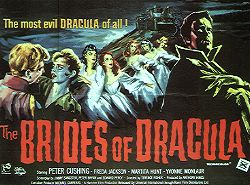
Brides
is perhaps slightly strange. Although Cushing returned as Van
Helsing, Christopher Lee has abandoned the scene, apparently
because he was worried about becoming type-cast. The plotline,
could easily be about Dracula. Baron Meinster (as played by David
Peel) is a pathetic character at first but one who proves most
cunning and perhaps surpassing Dracula, as he sinks his fangs into
Van Helsing's neck, but like Captain Kronos he survives, and the
scene where Van Helsing drives out the poison is still horrific,
nearly 40 years on. Despite the title, Dracula is absent from the
film. Van Helsing continues to develop as the young hero. Cushing
shows off his athletic ability again, and his relative youth, as
he leaps over high walls in a to the death struggle.
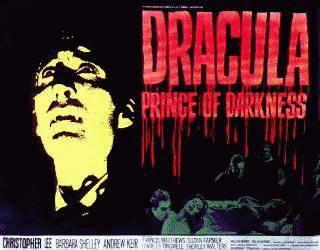 Dracula:Prince
of Darkness 1965 CHRISTOPHER LEE
Dracula:Prince
of Darkness 1965 CHRISTOPHER LEE
Prince
of Darkness is the first of the series to omit the character
of Van Helsing. Well, not quite. In the prologue to the story, we
are treated to a reminder of the events of Dracula (1958)
in an edited film insert of the climax to the first film showing
the confrontation between Van Helsing and Dracula as they battle
to the death. Lee however returns as the evil count in a
portrayal which has every effect on the imagination. With actors
such as Barbara Shelly, Francis Matthews and Andrew Keir in the
cast, most of the action for the first 45 minutes concerns the
small family of explorers and their encounter of the castle, and
Andrew Keir's warning (as a monk) to stay away. Naturally they
ignore his warning and are brought to the castle in a great black
horse driven carriage. They encounter the manservant of Dracula,
who claims to be looking after the house since the loss of his
master. The scenes of the servant restoring Dracula to life are
needless to say, rather gruesome, and then Dracula finally makes
his appearance more than half-way through the film. The tension
built up as a result of this works to fantastic degrees and
Hammer manages to live up to its Horror mastery. Dracula's rôle
develops further in that he has no speech throughout the film,
merely using his powerful appearance, showing yet again, Lee's
dominance over the cinema screen. The death scene is naturally a
major part and rather than rely on the repulsion to light, they
play upon the belief that clear running water is fatal to a
vampire, closing on a dying Dracula. Perhaps the most interesting,
yet oft stated fact about Prince of Darkness is the fact
that it was shot back to back with Rasputin: The Mad Monk,
using the same sets and cast. Naturally the overlap is obvious,
and at times one can easily forget which of the two pictures one
is watching, particularly as Francis Matthews seems to be
portraying the hero on both occasions.
Dracula
Has Risen From the Grave
1968
CHRISTOPHER LEE
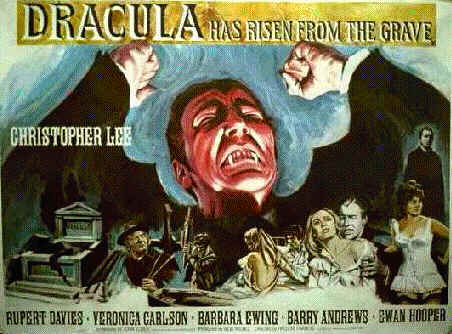
Taste
the Blood of Dracula
1969 CHRISTOPHER LEE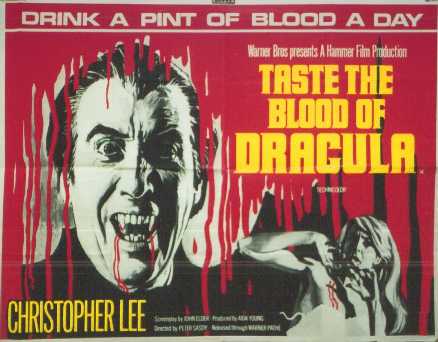
The
Scars of Dracula 1970 CHRISTOPHER LEE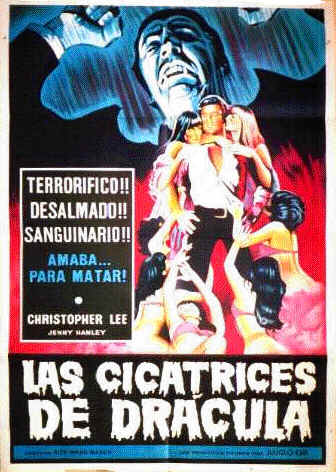
Scars was actually
the first Hammer film I actually remember watching, on video
whilst staying at my Gran's some years ago. The film then
influenced me greatly, and I have always remembered vividly four
things from the film, the gruesome opening in the village church
(buy the video and see what I mean), the frenzied exodus to from
the village to the castle to burn out Dracula (rather like Twins
of Evil in that respect), the death scene (which now that I
think of it, is rather like the death of the priest in The
Omen in certain aspects), and the performance of Patrick
Troughton as the manservant. Patrick is one of my favourite
actors ever, and Hammer used him usually as a manservant since
Karl the Bodysnatcher in the first colour Hammer The Curse of
Frankenstein in 1957. By now the emphasis in the features is
often on the other players in the script. Dracula though is more
sexual than ever before in the performance, and his confidence
overwhelming. The confrontation at the end between Lee and Dennis
Waterman (of Minder fame) is powerful, and it is a
foolish oversight which sees Dracula end his life again. The
other aspect played out in the film is that of the violence of
Dracula towards his slaves. The issue is played up of his
horrific torture to Troughton's character, and in the end it is
this which persuades him to aid the heroes defeat the Count.
Dracula
AD1972
1972 CHRISTOPHER LEE and PETER CUSHING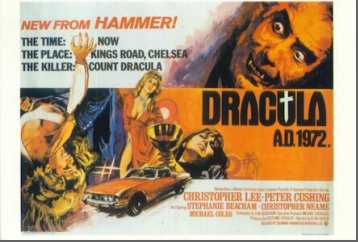
The first of
the series to be set in contemporary times. Incidentally there
was talk of a Hollywood re-make of this feature called something
like "Dracula 1999", but as yet nothing has come of it
so far as I am aware. Anyway, set in glorious Chelsea, in England,
the film opens with Lee being staked in an accident in one of
those great Van Helsing vs Dracula chases. We finally get to see
the Count defeat Van Helsing in the process and then the plot
moves off. In London's hippy infested streets a secret disciple
of Dracula summons up the great vampire in the midst of amongst
others, Van Helsing's great-great granddaughter (in the Church
where the original Van Helsing is buried). At least the idea that
Dracula and Van Helsing battled again in England is in keeping
with the original novel. As Dracula moves out and bodies are
discovered Peter Cushing plays Van Helsing's descendant, looking
remarkably like the original. Odd. The pace moves on and Van
Helsing mark II reluctantly continues the family business in a
bloody fest of vampire hunting at its finest. A pleasing result
for the feature, breathing its last into the Dracula series. Lee
returns to battle more angry than ever and as a bonus we get two
Dracula deaths in the one film. For the girls, Christopher Lee is
back commanding immense sexual air as the Count, and for the boys,
well we get Caroline Munro again, don't we.
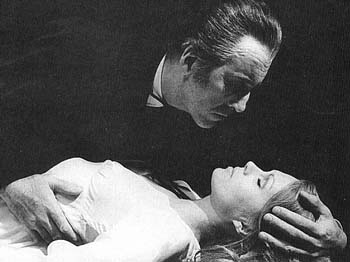 The Satanic Rites of Dracula 1973
CHRISTOPHER LEE and
PETER CUSHING
The Satanic Rites of Dracula 1973
CHRISTOPHER LEE and
PETER CUSHING
An often
criticised entry in the Dracula series, continuing with the
notion that Dracula is now battling with Van Helsing's descendant,
and a part for Joanna Lumely as well! Van Helsing by now is much
more adept with dealing with the vampire foe, and actually seems
to be relishing in it. A bizarre subplot of germ warfare hides
the true identity of Dracula despite the inevitable rites to
resurrect the evil one. The climax this time is a relish as
Dracula hides in a busy commercial office block. The look of
sheer joy on Cushing's face when he works out and discovers the
Count is reason enough to watch this entry (that and Joanna
Lumley). The climax of the story once again is a Van Helsing /
Dracula confrontation, and Van Helsing leaves no stone unturned
as he prepares to thoroughly commit the Count to the ground. The
change in scene for the series works, though one can't help but
wonder why Dracula doesn't just do away with all those robes and
things. Perhaps it is just so he can trap Van Helsing, whilst
dressing himself up for marriage to Joanna. Hmmm.
The
Legend of the 7 Golden Vampires
1974 PETER CUSHING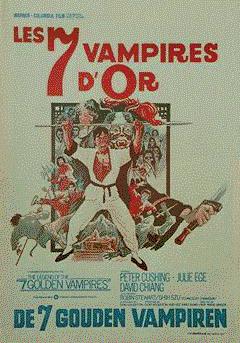
One of my favourites it has
to be said, simply for the camera techniques used in the raising
of the army of the dead. The series returns to the battles of the
original Van Helsing as he combats the 7 Golden Vampires which
stalk a small village in Hong Kong. The cast is made up of many
of lesser acting ability, but Van Helsing and his son shine
through in lead characters. The blend of Kung-fu and vampires
works surprisingly well and is a refreshing alternative to the
usual ritual. Dracula himself appears, having been written into
the script, half-way through production and this does tend to
show. Chris Lee is absent and one is surprised when Van Helsing
asks Dracula to reveal his true form, why he seems to recognise
the Count, despite dodgy eye-brows and deep booming voice.
However Cushing is on top form, albeit dressed in much the same
manner as his descendants in the previous two films. An anti-climax
to the Dracula series, but very much a worth-while film. They had
planned to carry on with the Van Helsing story, and had proposed
a feature set in India, but alas Legend of the 7 Golden
Vampires failed at the box office, and with the studios in
rapid descent we were robbed of another Lee and Cushing double
bill as Van Helsing and Dracula.
And so ends the Dracula
series. The adventures go beyond the confines and the death which
Bram Stoker had placed upon the character, and they develop the
relationship into something of a Holmes & Moriaty type.Whereas
the studios ignored much of the original book, they kept the feel
of the series and characters rather well, I think. Christopher
Lee played Dracula on many occasions outside the Hammer films,
and is the actor who has most often portrayed the Prince of
Darkness. He recently commented that he wouldn't play the role
for which he is most famous again, unless it kept very close to
the original story as laid down by Stoker. Lee may never get the
chance as to play the difinitive Dracula in the diffinitive
Dracula film but those which he did give us, with Peter Cushing
as the difinitive Van Helsing will be fondly remembered forever.
text © RJE Simpson 1999, 2006
Page posted 8th August 1999
reformatted and reposted 24 August 2006
-
back to top -
